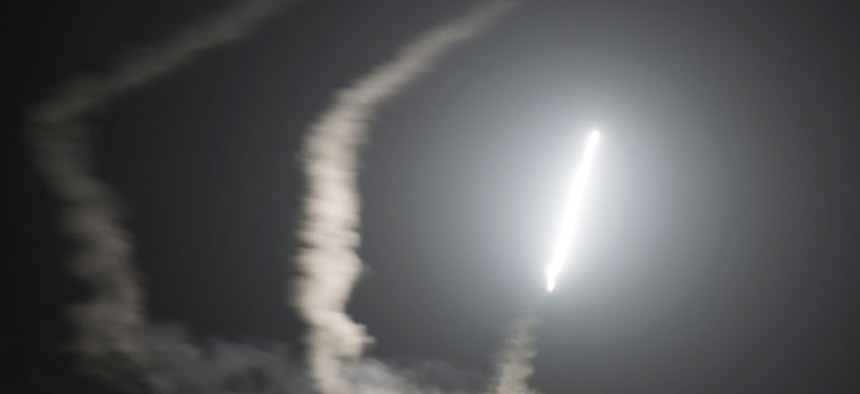
The guided-missile cruiser USS Philippine Sea launches a Tomahawk cruise missile to conduct strikes against ISIL targets earlier this week. Defense Department
On Monday night, the United States struck targets in Syria for the first time as part of its expanded air campaign against ISIS—a campaign that had previously been limited to the Iraqi side of the terrorist group's border-spanning domain. But the anti-ISIS mission Barack Obama outlined in an address on September 10—"We will degrade and ultimately destroy ISIL"—had expanded in another way, too, as the U.S. launched strikes on a separate group in Syria that many Americans hadn't heard of until recently. The Khorasan Group, which the president introduced briefly on Tuesday morning as "seasoned al-Qaeda operatives in Syria," appears to be part of a faction that is actively fighting ISIS, meaning America has now bombed two opposing sides of Syria's many-sided civil war. Has the military operation announced by the president only weeks ago already outgrown its original mission?
The Khorasan Group made no appearance in Obama's speech warning Americans that U.S. airstrikes in Syria were likely. And it's unclear what the group's exact relationship is to al-Qaeda's better-known affiliate in Syria, Jabhat al-Nusra, or even whether it's a distinct entity. Regardless, al-Qaeda's international leadership has disowned ISIS, and at the local level, forces associated with al-Qaeda have fought the group for territory. ISIS, for its part,has been blamed for assassinating senior al-Qaeda figures in Syria.
It's unusual, but not unprecedented, for the United States to attack opposing sides of a fractured civil war, says Stephen Biddle, an adjunct senior fellow for defense policy at the Council on Foreign Relations. During the 2003 Iraq War, the U.S. was at one point fighting both al-Qaeda in Iraq and more secular Sunni militants, who were opposed to each other, as well as the Shiite Mahdi Army, whichfought the other two. There are other instances in which the U.S. has indirectly helped two opposing sides in a conflict—for example, by paying protection money to Taliban affiliates to keep trucking routes open while supporting Afghan security forces in their fight against the Taliban.
More generally, the kind of factionalism we're seeing in Syria is common in civil wars, especially since the end of the Cold War, when proxy fights between the U.S. and the Soviet Union produced a simpler framework in which America could pick one side and bomb the other. Even among insurgent groups, however, the Syrian opposition is particularly fragmented. Paul Staniland, an assistant professor of political science at the University of Chicago and the author ofNetworks of Rebellion: Explaining Insurgent Cohesion and Collapse, tells me that the variety of forces fighting the Assad regime, and the infighting and shifting allegiances among them, means that the U.S. is "trying to create a side, rather than pick a side" since "we didn't really know what our side looked like" as the Syrian civil war dragged on. Given that the U.S. now arguably has at least three distinct enemies in Syria—the Assad regime, ISIS, and al-Qaeda affiliates—the enemy of America's enemy isn't necessarily America's friend. Staniland says bombing some anti-Assad forces while strengthening others is a version of "very publicly trying to take out part of the coalition that is fighting your enemy, in order to support the rest of that coalition against the enemy.”
It's all pretty convoluted, but is it mission creep? Andrew Bacevich, a professor at Boston University who specializes in military history, writes via email that "[t]he temptation to expand the mission is inherent in the means employed. When relying on air power, it’s ever so easy to add a couple of aiming points to the target list, even if the added targets have nothing to do with the nominal purpose of the announced mission." Obama was careful to say that the strikes against the Khorasan Group were aimed at disrupting a plot against the United States—one that the military called "imminent" in its own announcement about the strikes. Such a characterization could give Obama legal cover to move against the group without congressional authorization.
But more broadly construed, the "mission" Obama outlined on September 10 was to go after Islamist militants in Iraq and Syria. Now that U.S. jets are conducting bombing raids over airspace the Syrian regime controls, however, there is a danger that a Syrian missile could hit an American aircraft, which would then likely tempt the U.S. to open a third front in Syria by bombing the Syrian regime as well. "In the palette of colors that is mission creep," Biddle says, "that would be a rather brighter color."
Regardless, with the mission of Obama's September 10th speech so vaguely defined—“We will conduct a systematic campaign of airstrikes against these terrorists. … If you threaten America, you will find no safe haven”—it's hard to tell what the U.S. mission is creeping from, or what it might be creeping to.







